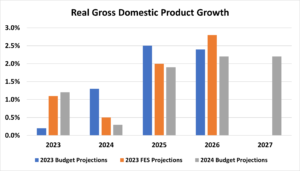Ontario Tories lay out post-election path to balance: Ontario Budget 2024
Finance Minister Peter Bethlenfalvy has released Ontario’s 2024 Budget, Building a Better Ontario. As is typical of mid-mandate fiscal plans, Budget 2024 focuses on the government’s progress on its plan to “Build Ontario.”
Infrastructure, housing, and cost of living continue to be top of mind for the Ford government as it approaches the two-year anniversary of its 2022 election victory. However, ongoing affordability challenges and an ever-changing political landscape mean Ford will be facing headwinds as he looks towards an election in 2026.
Budget updates – supporting communities, lowering costs, and fiscal outlook
The architects of Ford’s 2024 Budget have built it around two familiar campaign-style slogans – “Building Ontario” and “Working for You” – which the government continues to use to drive its communications and policy priorities. As a result, the budget increases spending for several existing programs, but introduces limited new initiatives:
- Enhanced municipal funding, including a new $1 billion Municipal Housing Infrastructure Program and enhancing the Housing-Enabling Water Systems Fund to total $825 million. In addition, $200 million over three years in the new Community Sport and Recreation Infrastructure Fund and a new $30 million Fire Protection Grant for municipal fire departments.
- Taxpayer relief measures, such as extending the province’s gas tax reduction to the end of this year, expanding the Ontario Guaranteed Annual Income System (GAINS), and continued advocacy against a federal and provincial carbon tax. The government also indicates that more options for auto-insurance will help lower costs and increase options for drivers – particularly those in the electorally-significant 905.
- Community funding, like a four per cent increase to hospital base funding, an additional $2 billion over three years to support access to, and expansion of, home care, and nearly $1 billion over three years to address immediate healthcare staffing needs ($743 million) and mental health and addictions services ($396 million). The government is also focused on reducing crime, particularly auto theft, through $49 million in support.
These marquee policy initiatives are underscored by a revised fiscal plan. Ontario now forecasts a deficit of $9.8 billion for 2024-25 and plans to balance the books by 2026-27 with a modest surplus of $500 million – after the next election. Note that Budget 2024 continues to allocate significant contingency funds (nearly $1.5 billion this year) which the government has historically used to address unexpected financial pressures – giving Ford and Bethlenfalvy the flexibility to adjust their plan ahead of the next election.
By the numbers – economic projections and housing
Behind the political communications that accompany the budget are significant indicators which will impact the government’s direction over the coming years.
The Ontario economy was more resilient than anticipated in 2023 with real gross domestic product (GDP) growing by an estimated 1.2 per cent. The Government of Ontario expects much slower economic growth in 2024 (+0.3 per cent). This will result in a higher unemployment rate (6.7 per cent) that will linger in the coming years. While the economy will slightly rebound, Ontario will experience relatively modest real GDP growth between 2025 and 2027, hovering around the two-per-cent mark.

After being negatively impacted by rising interest rates, projected housing starts have stabilized. They are up a total of 6,300 between 2023 and 2026 compared to the projections in the 2023 Fall Economic Statement. The province expects housing starts to reach 95,800 in 2027. However, the current pace will make it difficult for the government to hit its target to build 1.5 million new homes by 2031.
The path ahead
The next election is over two years away, but upcoming by-elections in both Lambton-Kent-Middlesex and Milton will be viewed as an early indication of the current government’s re-election chances. Expect the PCs and the Liberals to focus their attention on Milton in the coming months – such as Ford’s commitment to two-way all day GO service, and the beginning planks of Crombie’s “abundance agenda.”
In addition to immediate electoral pressures, the government will continue to grapple with the high cost of living in Ontario. Currently, public discourse has coalesced around the federal carbon tax – which Minister Bethlenfalvy noted several times in his budget speech – but gradually slowing inflation, a cautiously optimistic economic outlook, and a federal election set to occur before the next provincial election mean the affordability debate will continue to evolve.
As the PC government forecasts a return to budget balance after the next election, Ford and his Cabinet will be expected to keep spending under control as they position themselves as the only alternative to the Liberals and NDP – leaving limited room for high-cost affordability initiatives ahead of 2026.
Strategically, the PCs are responding to this challenge by focusing on the government’s core strength – infrastructure projects – while building their record against a political threat – healthcare. Although this budget does not commit to a significant amount of new spending, the government will continue to preserve the limited flexibility it has to whether any unexpected challenges this year while planning for two more budgets before election 2026.